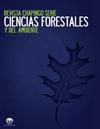Populations of Pinus radiata D. Don differ in low-temperature tolerance and growth rate
IF 0.6
4区 农林科学
Q3 Agricultural and Biological Sciences
Revista Chapingo Serie Ciencias Forestales Y Del Ambiente
Pub Date : 2020-08-30
DOI:10.5154/r.rchscfa.2019.12.096
引用次数: 0
Abstract
Introduction: In Pinus radiata D. Don, one of the most widely planted pines globally, frost damages plantations at the seedling stage. Objective: To determine differences in growth and tolerance to low temperatures of native populations (Guadalupe and Cedros islands) of P. radiata in greenhouse and outdoors conditions, under different levels of soil moisture. Materials and methods: Low-temperature tolerance was determined through the damage index (DI) in freezing tests at -12 °C during 4 h. In each environment (greenhouse and outdoors) two soil moisture treatments were defined (irrigation and drought). The DI was evaluated with the method of electrical conductivity in primary needles during winter and spring. The absolute growth rate (AGR) of the terminal shoot was obtained by measuring the total height of the seedlings. Results and discussion: Average DI of 50 and 64 % were obtained in winter and spring, respectively. In greenhouse, DI was different (P ≤ 0.05) between populations, being higher in Guadalupe (>59 %) than in Cedros ( Conclusion: The population of Guadalupe is more sensitive to low temperatures with greater variation in DI, due to its growth dynamics. Differences between populations are useful in the genetic improvement of the species.辐射松(Pinus radiata D. Don)种群在低温耐受性和生长速度上存在差异
辐射松(Pinus radiata D. Don)是全球种植最广泛的松树之一,在幼苗期,霜冻会破坏人工林。目的:研究不同土壤湿度条件下,瓜达卢佩岛和塞德罗斯岛天然种群辐射木(P. radiata)在温室和室外条件下的生长和低温耐受性差异。材料与方法:低温耐受性通过低温-12℃4 h冻害指数(DI)测定。在每个环境下(温室和室外)定义了两种土壤水分处理(灌溉和干旱)。采用冬春两季初生针叶电导率法评价其DI。通过测量幼苗的总高度,得到顶梢的绝对生长率。结果与讨论:冬季和春季平均DI分别为50%和64%。在温室中,不同种群间DI差异显著(P≤0.05),瓜达卢佩种群DI高于雪松(P < 0.05)(结论瓜达卢佩种群对低温更敏感,DI变化更大,这与瓜达卢佩种群的生长动态有关。种群间的差异对物种的遗传改良是有用的。
本文章由计算机程序翻译,如有差异,请以英文原文为准。
求助全文
约1分钟内获得全文
求助全文
来源期刊
CiteScore
1.20
自引率
16.70%
发文量
0
审稿时长
>12 weeks
期刊介绍:
The Revista Chapingo Serie Ciencias Forestales y del Ambiente (RCHSCFA) is a scientific journal that aims to raise awareness of high-quality research products related to forest, arid, temperate and tropical environments in the world. Since its foundation in 1994, the RCHSCFA has served as a space for scientific dissemination and discussion at a national and international level among academics, researchers, undergraduate and graduate students, forest managers and public/private entities that are interested in the forest environment.
All content published in the journal first goes through a strict triple-blind review process and is published in the following formats: Scientific Articles, Review Articles, Methodologies, Technical or Technological Notes.

 求助内容:
求助内容: 应助结果提醒方式:
应助结果提醒方式:


